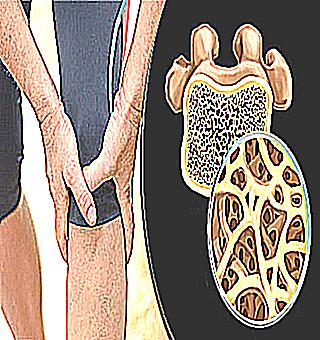Home >
Erectile Dysfunction >
Osteoporosis symptoms and treatment
Osteoporosis - symptoms and treatment

Treatment goals:412
- prevent or reduce fractures;
- increase bone density;
- improve markers of bone remodeling.
First of all, for the prevention of fractures in osteoporosis, lifestyle correction measures are required:1213
- Growing mass and exercising to strengthen muscles and improve balance
- Ensure optimal intake of calcium and vitamin D as an adjunct to active therapy.
Drug treatment
Drug therapy for osteoporosis is prescribed for postmenopausal women and men over 50 in the following cases:4
- femoral or vertebral fracture;
- DXA test results - T-score equal to or less than -2.5 SD for femoral neck or vertebrae after excluding causes of secondary osteoporosis;
- low bone mass (T-score between -1.0 and -2.5 SD for the femoral neck or spine) and a 10-year FRAX probability of 3% or more for a hip fracture or 20% or more for a major osteoporotic fracture) .
Federal clinical guidelines for the diagnosis, treatment and prevention of osteoporosis provide for the use of:4
- antiresorptive drugs - aimed at suppressing bone resorption by acting on osteoclasts (bisphosphonates, denosumab);
- anabolic drugs - aimed at enhancing bone formation (teriparatide).
BISPHOSPHONATES
These drugs disrupt the work of osteoclasts, preventing the destruction of bone. Accumulating in the bone tissue, they have a delayed effect with the preservation of the effect for months after discontinuation of treatment.
Adverse events. When using bisphosphonates inside, adverse effects from the gastrointestinal tract are possible - difficulty in swallowing, esophagitis and gastritis. With intravenous administration of bisphosphonates, a flu-like reaction may occur - fever, pain in the joints and muscles, weakness, etc. The severity of such symptoms decreases significantly after repeated intravenous injections, and their complete disappearance occurs after 2-3 days. Flu-like reactions can be alleviated with the help of non-steroidal anti-inflammatory drugs. In rare cases, against the background of long-term use of bisphosphonates (more than five years), there have been cases of osteonecrosis of the jaw.
Contraindications and restrictions:
- hypocalcemia;
- severe renal dysfunction (creatinine clearance less than 35 ml/min);
- mineral metabolism disorder (vitamin D deficiency, osteomalacia, hypophosphatasia, hypophosphatemia) ;
- breastfeeding;
- children and adolescents under 18.
The use of bisphosphonates orally is contraindicated in diseases of the esophagus that violate its patency, the inability of a person to be in an upright position for 30 minutes. These drugs are used with caution in diseases of the gastrointestinal tract in the acute phase.
Application. All bisphosphonate tablets (alendronate, risedronate, ibandronate) are taken in the morning on an empty stomach 30 minutes before meals. The tablet is washed down with a glass of water, after which it is necessary to be in an upright position for about 30-40 minutes, without taking food or liquid, except water.
Intravenous drugs are used every three months (ibandronate) or once a year (zoledronate).
DENOSUMAB
This drug is designed to block the process of attracting active osteoclasts. Unlike bisphosphonates, denosumab reduces the production of osteoclasts, but the function of mature cells is not impaired. The drug does not accumulate in the bone tissue, its action stops after treatment. It is safe for kidney dysfunction.
Denosumab is available as a pen, injected subcutaneously every six months.
Possible side effects:
- skin reactions;
- bloating;
- hypocalcemia.
Contraindications:
- hypocalcemia;
- hypersensitivity to the drug;
- pregnancy or lactation.
TERIPARATID
This drug has a predominant effect on osteoblasts, increasing their lifespan. Thus, it enhances bone formation and activates modeling in certain areas of the skeleton. Recommended for use by patients with severe osteoporosis and when treatment with other drugs is ineffective.
Teriparatide is administered subcutaneously at 20 mg once a day daily, stored in the refrigerator.
Undesirable effects: dizziness, leg cramps.
Contraindications:
- hypercalcemia;
- hyperparathyroidism;
- osteogenic sarcoma;
- uncovered growth zones;
- history of skeletal irradiation;
- pregnancy or lactation;
- malignant bone formation or bone metastases;
- allergic reaction to the drug.
CALCIUM AND VITAMIN D
All drugs aimed at combating osteoporosis should be taken in combination with calcium (500-1000 mg / day) and vitamin D (800-1000 IU / day), since the effectiveness of this combination has been clinically confirmed.
In addition, potentially treatable causes of secondary osteoporosis are treated if they are found.
ANALGESICS
Another goal of treating patients with osteoporotic fractures is to control pain, which can be severe in vertebral compression fractures and seriously impair quality of life. In this case, pain medications are prescribed, which are taken by mouth in the form of tablets or capsules as needed or on a regular basis. Physiotherapy and transcutaneous electrical nerve stimulation are also used for pain relief.5
Other treatments
A good effect in the treatment of osteoporosis dates mechanical support of the spine and, in some cases, orthoses for the thoracic spine (orthopedic corsets). They perform a supporting function, removing part of the axial load from the thoracic and lumbar spine, and limit movement in the spine. It is recommended to wear an orthosis if the patient intends to walk or stand for more than an hour, but it is important to limit the wearing time, as prolonged immobilization promotes bone demineralization.
Surgical treatment is used for a fracture of the femoral neck, as well as for severe deformities of the chest that have arisen against the background of multiple compression fractures of the vertebrae.
During the rehabilitation period after fractures, classes with a specialist in physical therapy (exercise therapy), breathing exercises, exercises to strengthen the pectoral and intercostal muscles are recommended.12



























